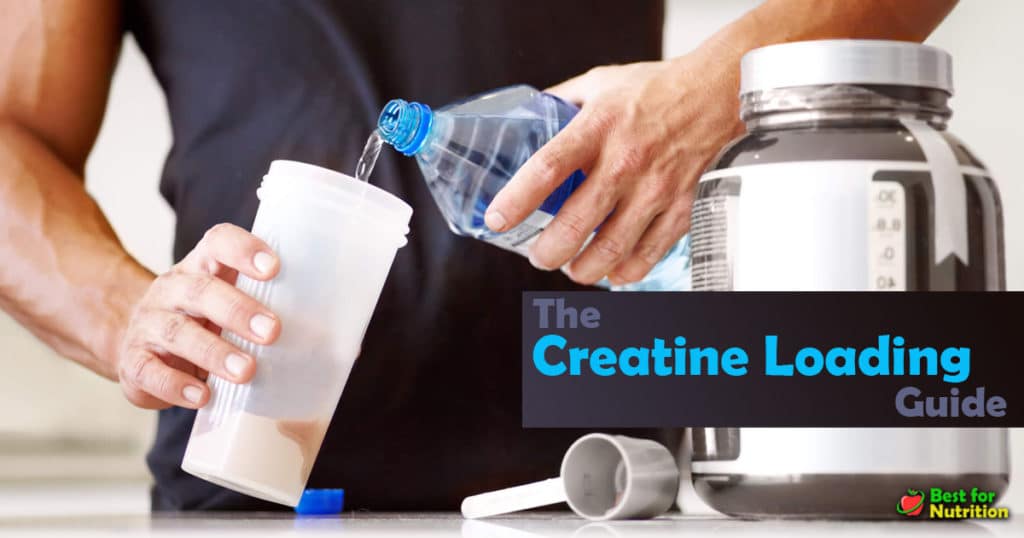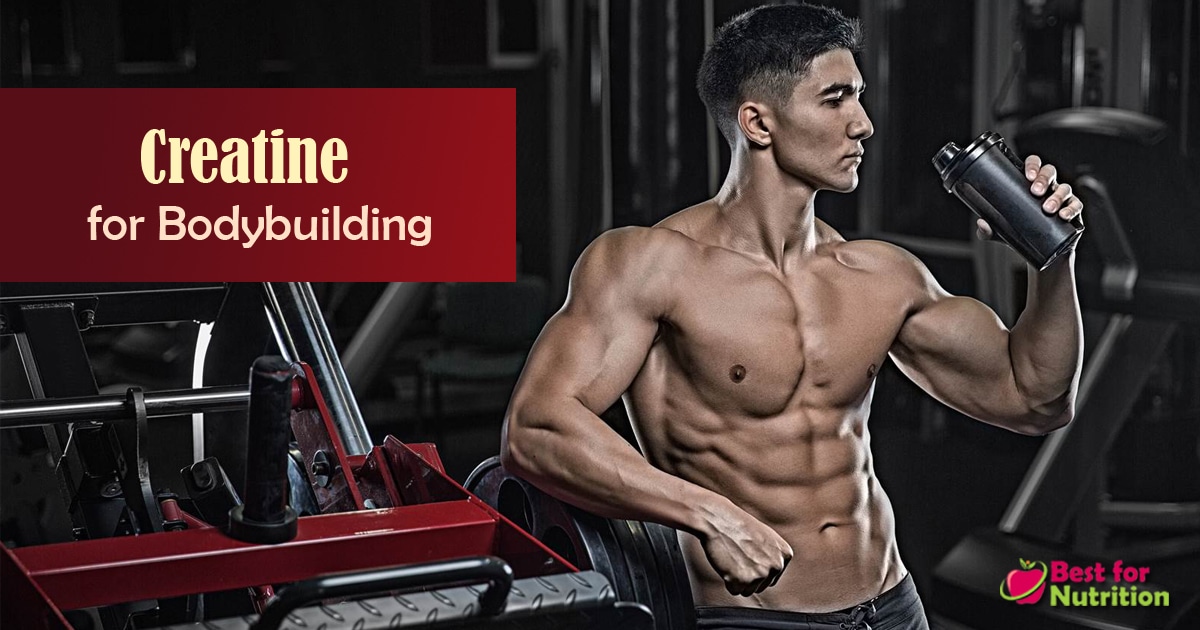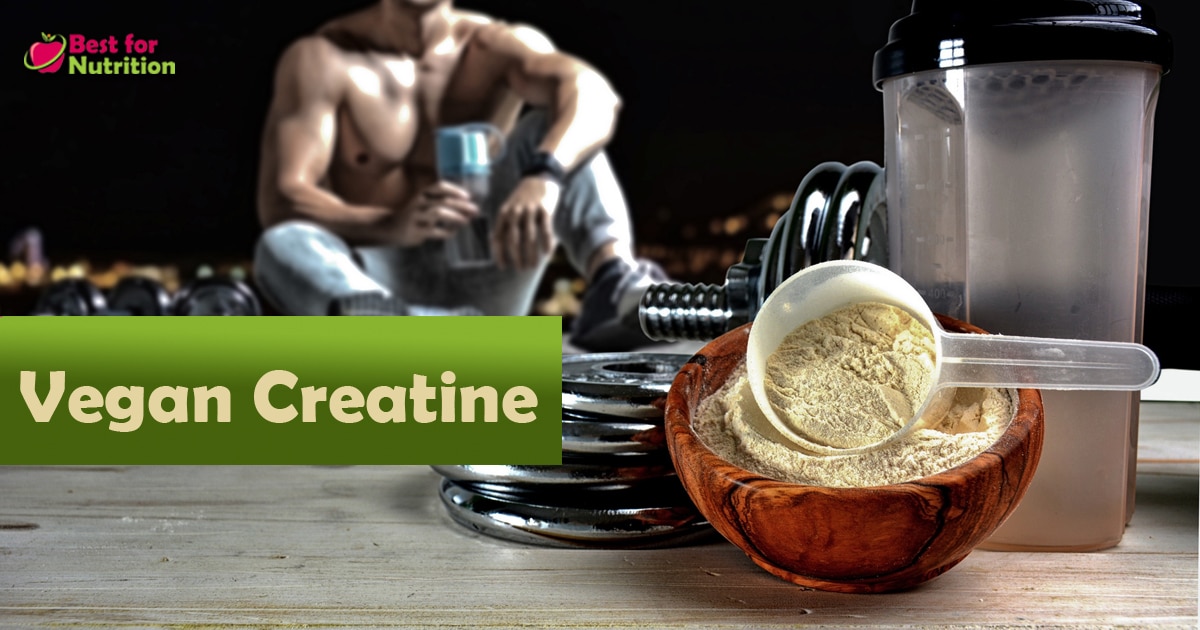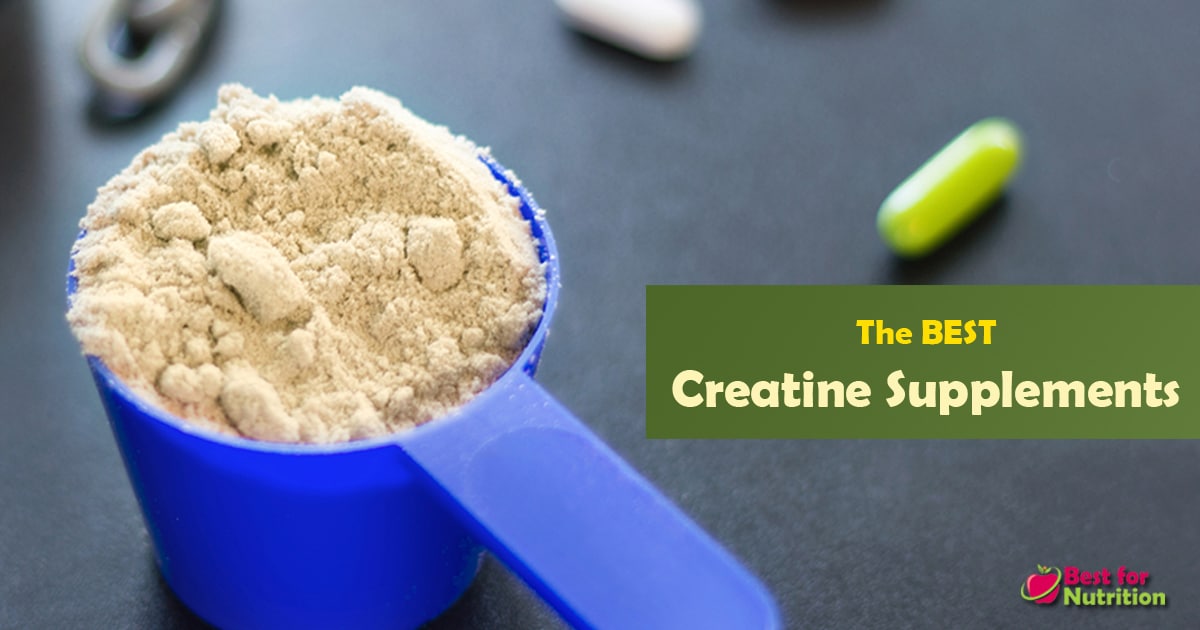Creatine supplements have become the preferred choice of sportspersons, athletes, and fitness enthusiasts alike for its quick results. But for those using creatine supplements for the first time, phrases like creatine loading may sound confusing.
A creatine loading phase is recommended by trainers to maximize muscle stores of creatine.
This is a phase of creatine supplementation in which a relatively high amount of creatine is consumed in a short span of time in an attempt to saturate your muscles with it.
If done correctly, creatine loading is a safe practice and it does offer you some benefits.
Read on to learn everything you need to know about creatine loading, benefits, dosage, risks, and most importantly how to do it correctly.
- What is Creatine?
- What is Creatine Loading?
- When is Creatine Loading Necessary?
- Benefits of Creatine Loading
- Creatine Dosage: How Much Creatine Should I Take?
- The Risks & Side Effects of Creatine Loading
- FAQs

What is Creatine?
Creatine is a chemical compound made up of three amino acids, namely glycine, arginine, and methionine. The main function of creatine is to generate energy and improve exercise performance.
Studies show that 95% of creatine produced by the body naturally is stored in the muscles while the remaining 5% is deposited in the liver, kidneys, and brain in the form of phosphocreatine (1).
Researches also show that intake of creatine supplements leads to a significant increase in strength and helps in the building of fat-free mass (2).
These properties make it one of the most commonly-used supplements by athletes to improve their performance, especially those involved running, cycling, jumping, sprinting, etc.
Creatine loading is a process used by athletes to optimize the creatine levels in the body.
What is Creatine Loading?
Creatine loading is one of the commonly used procedures which helps our body maximize creatine levels.
The emphasis during the loading stage is on consuming creatine in high amounts within a short duration, thus, saturating the creatine reserves in muscles.
The saturation is done because consuming creatine-rich foods (like fish) provides our bodies with 60-80% of the creatine requirements.
Creatine loading has shown to increase the creatinine levels by 10%- 40% (3).
Another important aspect to note is that when creatine supplements are consumed, they lead to increased production of high energy molecules known as ATP. Higher amounts of ATP help the body to enhance performance while exercising.
It has been found that athletes experience less fatigue when their creatine levels are maximized (4).
Summary: Creatine loading is a way to improve creatine levels in the body by consuming large quantities of the supplement. It is usually used by athletes because it helps improve performance and boosts energy levels.
When is Creatine Loading Necessary?
While many athletes prefer creatine loading to improve their performance, it is worth asking whether the process is also beneficial or even necessary for others?
Health experts believe that loading might not be essentially required all the time. The main purpose of loading is to keep muscles loaded with creatine and improve energy levels and performance.
However, studies have also shown that a result of loading can be achieved by consuming a relatively lower dose over a longer duration of time as well (5).
Thus, loading is recommended only in cases where quick results are needed.
There are, however, a few benefits of maintaining high levels of creatine:
Helps in Muscle Gain
Creatine has proven to be significantly effective in muscle gain by improving muscle mass.
Studies have established that creatine loading helps in muscle gain by the ability to perform high-intensity exercises resulting due to more ATP produced (6).
Leads to Lesser Injuries
It has been observed that athletes who take creatine supplements also report fewer instances of injuries or muscle sprains.
A comprehensive study undertaken with football players found that athletes consuming creatine supplements faced fewer injuries and attended practice sessions more regularly (7).
This can be attributed to the fact that taking creatine helps develop more endurance and thereby reduce the chances of injury or muscle sprain.
Increases Muscle Strength
Studies have shown that higher creatine levels can increase muscle strength by 15% when combined with resistance training (8).
Improves Exercise and Performance
Creatine aids high-intensity exercises through increasing strength, reducing fatigue, and improving muscle mass by increasing phosphocreatine stores in muscles.
Observations made by reviewing various works of literature give enough proof that performance during high-intensity workouts is enhanced by 15% in some cases (9).
Aid Brain Performance and Recovery
Improved creatine levels can also help the brain work better and fight diseases.
Although most existing studies have been performed only in animals, it can potentially help with several neurological disorders, like Alzheimer’s, Parkinson’s, epilepsy, or even brain and spinal cord injuries.
One study that had children with brain injury as their subjects saw fatigue levels drop and reduced dizziness (10).
Similarly, creatine is known to help the elderly and people with neurological diseases (11).
It can also help vegetarians, who do not get creatine from meat or fish, improve memory, and intelligence (12).
However, there is apparently no benefit of creatine on the brain function in healthy adults (13).
Summary: Creatine loading is usually required only when the results are expected quickly, usually in a few days. Higher levels of creatine help gain muscle mass and strength, aid exercise and physical performance, and even improve brain function.
Benefits of Creatine Loading
Like is the case with every supplement or treatment, creatine loading also has positive and negative effects. Let us have a look at the pros and cons of the creatine loading process.
Provides Results Instantly
Creatine loading provides instant results with visible muscle gain and increased mass.
An improvement in energy levels and superior physical performance while exercising can also be experienced almost immediately after starting creatine loading.
Consistent and Sustainable
Another benefit is that consistent results can be achieved over time by consuming creatine supplements for longer duration; thus, making it a convenient option.
You can take creatine supplements over a long period without any significant side effects as well.
Bigger Muscles
A person who undergoes creatine loading experiences bigger and fuller muscles owing to water retention caused by an increased glycogen and creatine levels.
Though not necessarily a benefit, improved muscles can act as an excellent motivation for those who are working to build up their bodies.
Summary: Creatine loading gives instant results and is a simple way to keep creatine levels high in the body. This is beneficial for bodybuilders and sportspersons to improve their muscle mass and performance.
Creatine Dosage: How Much Creatine Should I Take?
According to the International Society of Sports Nutrition (ISSN), the recommended dosage is 20 grams creatine (divided into 5 grams per serving). A serving can be taken four times a day, for 5 to 7 days, to increase the creatine levels in the body (14).
They also suggest that a person multiply their body weight by 0.3 g/kg to determine the right amount of creatine dosage required per day.
Studies show that a dosage of 3 grams per day, taken for 28 days, gives the same levels of creatine boost as that of 20 grams per day, taken for 5-7 days (15).
Generally, the levels of creatine start to drop once the supplements are discontinued.
Thus, people usually continue to consume small quantities of the supplement to prevent the depletion of creatine stores in the muscles.
Summary: During the loading phase of the cycle, you can take 5 grams of serving four times a day. Alternatively, you can also take 3 grams of creatine supplements per day for 28 days for similar results.
The Risks & Side Effects of Creatine Loading
It has been observed that many people undergoing creatine loading are unable to tolerate the high amount of creatine supplements that are to be consumed daily.
Some of the common side effects and risk factors associated with creatine are as follows:
Creatine Usage May Cause Dehydration
It was commonly believed that higher levels of creatine cause dehydration in the body, and as a matter of fact, adequate water intake was an important part of the process.
The explanation was that since creatine leads to higher water retention in muscles, it may lead to dehydration, and ultimately cramps. However, more recent studies contradict these claims.
Studies show that creatine supplements did not cause dehydration in training or high-intensity exercises (16, 17).
Using Creatine May Lead to Weight Gain
Scientific evidence suggests that taking creatine supplements may result in increased weight (18).
However, this is due to increased muscle mass and water retention in the body.
Studies show that you can gain approximately 2-6 points of weight during the creatine loading phase (19).
Creatine May Harm Kidneys and Liver
Creatine was thought to impact the kidneys and liver as well adversely. But, more recent studies show that there are no significant negative effects on these organs (20, 21, 22).
However, these studies were conducted with athletes and physically fit subjects. People with irregular or reduced kidney function might have their existing issues worsened due to creatine loading (23).
Thus, it is advisable that you consult your physician before starting creatine supplements, especially if you have or ever had any renal disease.
Creatine May Cause Issues with Digestion
Research shows that subjects administered with creatine supplements report high instances of diarrhea and belching (24). Others may experience nausea and stomach ache, among other issues (25).
Summary: Increased creatine levels have been associated with dehydration, liver and kidney-related issues, digestion problems, and weight gain. While new evidence shows that some of these issues are not caused by creatine, more research is required to identify the side effects accurately.
Frequently Asked Questions (FAQs)
Is it Safe for Women to Take Creatine?
Yes, women can consume creatine supplements. Women sprinters often use creatine, and no significant side effects of creatine supplements on women have been established yet.
However, since most studies related to creatine supplements have been conducted on male subjects, there is a need to undertake women-centric studies as well.
How Do I Take Creatine Supplements?
First, you should consult your physician regarding the use of creatine supplements. Only when you are able to decide the dosage should you start taking them.
Creatine supplements are easily available in the market in several forms, but the most popular are powders and capsules.
You can take either of them, with water or your workout shakes. Powder supplements usually have faster absorption than capsules, so they are a better choice as a pre-workout supplement.
Mixing creatine supplement in a glass of warm water makes it dissolve much faster, especially if it’s creatine monohydrate.
The addition of milk to creatine raises your insulin which in turn helps your muscles to take in more creatine.
You can get the same benefit from fruit juice as well, so try mixing your creatine with some grape juice for a tasty drink. Most bodybuilders seem to prefer using milk rather than juice for taking creatine as this offers them all the essential amino acids required for boosting muscle synthesis.
Try to take them at the same time each day.
What are the Different Phases of the Creatine Usage Cycle?
It starts with the loading process, where you take high quantities of creatine supplement every day for a few days. Depending on personal preferences, this phase may last from 5 to 7 days. You may even come across people who do this for two to three weeks.
This is followed by the maintenance phase, where you take lower quantities for a few weeks. And finally, you halt for a few days or a week before starting again.
You may begin with four doses each day for the initial five days (loading), and then reduce the dosage to two or three per day (maintenance).
About 15 to 20 grams of creatine are used daily in the loading phase. Take them in 5-gram doses spread out during the day, especially before and after your workout.
In the maintenance phase, you need to supplement only once a day with a 3 to 5-gram dose. Once the creatine saturation levels are reached, you can take a break for a week or two before resuming again.
Depending on your requirement, you follow the cycle of loading (5 days), maintenance (3 weeks), pause (1-2 weeks).
Is it Necessary to Cycle Creatine Usage?
There is no substantial proof which shows cycling creatine is better or effective in any manner. As stated earlier, smaller doses taken over a longer duration work effectively as well.
Cycling the creatine usage is not required if a person consumes a small amount daily, or on specific training days. It is also not needed if the person takes the creatine complex form of creatine supplement.
However, cycling can be done if a person has undergone loading and takes maintenance doses to keep the creatine levels optimal.
So, whether or not a person undergoes the cycling phase depends on how quickly they want results.
Thus, while creatine loading allows a person to reach desired levels of creatine in a short period, it is recommended to do so under the supervision of a trainer or instructor to reap in the maximum benefits.
What are Some of the Challenges of Undergoing Creatine Loading?
High doses of creatine may cause stomach discomforts, especially bloating and belching. The water retention due to creatine usage can lead to an increase in body weight. You may even gain more body as well.
Another major challenge of creatine loading is the cost of the supplements.
Creatine supplements, although not very expensive, need to be consumed in high quantities during the loading phase. This often forces people to purchase them in bulk because retail prices tend to be higher.
Thus, if you have the time, consuming smaller quantities of the supplements over a few weeks is a more suitable, manageable, and cost-effective method to improve your creatine levels.
What Happens When You Take too Much Creatine?
Once the muscles in the body are saturated with creatine, any additional consumption of the supplement is a waste. As the muscles reach their storage capacity, extra creatine in the body will be removed through excretion (26).
It might only increase the intensity of side effects, like a stomach ache or bloating.
That is why you should always stick to the recommended dosage suggested by your healthcare professional or trainer.
The Final Note
Creatine is thought to be one of the safest supplements for improving physical performance and increasing energy levels, without any potential long-term side effects.
Creatine loading, with high doses of creatine for a short period of time, is a popular practice among bodybuilders for saturating their muscles with creatine. Then they switch over to a lower dose of creatine for the maintenance phase before taking a break from this supplementation.
Though this practice does have its advantages, it is not necessary to do so. Regular supplementation at lower doses seems to be just as effective for most fitness enthusiasts.
Although it is a relatively low-risk supplement, it must be used as per the recommended dosages and under the guidance of expert supervision to avoid any anecdotal side effects.





